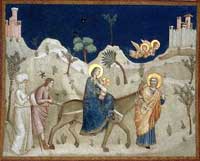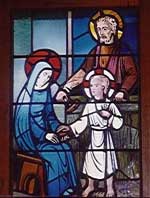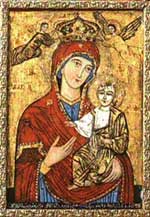|
Christianity in Egypt
The history of Christianity in Egypt dates back verily to the
beginnings of Christianity itself. Many Christians hold that
Christianity was brought to Egypt by the Apostle Saint Mark in
the early part of the first century AD. Saint Mark first came to
Egypt between the first and third year of the reign of Emperor
Claudius, sometime between AD 41 and 44, and he returned to
Alexandria some twenty years later to preach and evangelize.
Saint Mark's first convert in Alexandria was Anianus, a
shoemaker who later was consecrated a bishop and became
Patriarch of Alexandria after Saint Mark's martyrdom. This
succession of Patriarchs has remained unbroken down to the
present day, making the Egyptian Christian, or Coptic, Church
one of the oldest Christian churches in existence. Evidence for
this age comes in the form of the oldest Biblical papyri
discovered in remote regions of Upper Egypt. These papyri are
written in the Coptic script and are older than even the oldest
Greek copies of the Bible ordered by Constantine in AD 312.
The word Copt is derived from the Greek word Aigyptos, which
was, in turn, derived from "Hikaptah", one of the names for
Memphis. The modern use of the term "Coptic" describes Egyptian
Christians.
 The Egyptians before Christianity had always been a deeply
religious people, and many readily embraced the young religion,
having had their old beliefs effectively destroyed by the coming
of the Roman Empire and the final dethroning of the god-king
Pharaohs. Many of the concepts of Christianity were already
familiar to the Egyptians from their ancient religion, such as
the death and resurrection of a god, the idea of the judgment of
souls and a paradisiacal afterlife for the faithful. The ankh
too, the Egyptian symbol for eternal life, is very similar to
that of the cross revered by Christians (especially in the form
of the Coptic cross), itself also a symbol for eternal life.
Furthermore, the belief that God had chosen Egypt as a safe
place for His infant son to hide him from Herod was a great
source of pride to the Egyptian Christians. It was through
Christianity that the Egyptian culture survived the Roman
Dominion. The Egyptians before Christianity had always been a deeply
religious people, and many readily embraced the young religion,
having had their old beliefs effectively destroyed by the coming
of the Roman Empire and the final dethroning of the god-king
Pharaohs. Many of the concepts of Christianity were already
familiar to the Egyptians from their ancient religion, such as
the death and resurrection of a god, the idea of the judgment of
souls and a paradisiacal afterlife for the faithful. The ankh
too, the Egyptian symbol for eternal life, is very similar to
that of the cross revered by Christians (especially in the form
of the Coptic cross), itself also a symbol for eternal life.
Furthermore, the belief that God had chosen Egypt as a safe
place for His infant son to hide him from Herod was a great
source of pride to the Egyptian Christians. It was through
Christianity that the Egyptian culture survived the Roman
Dominion.
Yet these formative years were not without problems. Throughout
this time Christianity in Egypt was locked in an often deadly
struggle against the polytheistic religions of the Greco-Roman
culture as well as the Hellenistic movement that began in
Alexandria spread to other large cities. To counter Hellenistic
philosophy that often criticized the young religion, the
Christian leaders in Egypt established a catechetical school in
Alexandria, the Didascalia, founded in the late second century
AD. This school became the heart of what can only be called
Christian philosophy, and great teachers and orators such as
Clement and Origen were able to battle the Hellenistic
philosophers on their own ground and advocate Christianity in an
orderly and intellectual manner. It was also in this great
university of Christian learning that Christianity first
underwent rigorous studies that created its first theology and
dogma, as well as making the new faith accessible to all.
Pantaenus, the founder and first dean of the Didascalia, helped
the Egyptian people bridge the gap between Dynastic Egypt and
the new era by promoting the use of the Greek alphabet instead
of the Demotic ("cursive" hieroglyphics) in translations of the
Bible as well as in the writing of religious theses and letters.
Additionally, the school educated everyone who came to it in
Greek, opening the study of religion to just about everyone, and
making as many people as possible literate.
 Yet the greatest persecutions on the young religion came at the
hands of the Roman government. Emperor Nero had set the
precedent in AD 64, about the same time as the martyrdom of
Saint Peter. It was unusual, for the actual offense was simply
to be a Christian or to profess the Christian faith, rather than
any kind of criminal acts that might go along with it (such as
those later falsely attributed to Medieval heretics). An
arrested Christian could receive a pardon simply by offering
incense on a Roman altar, but many refused to do so, citing
scripture passages urging faith in the one God. Thus the true
"crime" of the persecuted Christians was their refusal to do
homage to the Roman gods, including the emperor. Those who did
refuse to bow to the Roman religion were imprisoned, often
tortured, thrown to the wild animals in the coliseum, or
suffered execution by any number of other means. Rather than
discouraging the Christians, these actions encouraged them and
reinforced their faith, echoing the words of Jesus that those
who suffered persecution because of his name were truly blessed.
These heroes of the Christians were called "martyrs," a word
that means "witnesses." In the first century this persecution
was largely done by the government, though after a few decades
they seem to have lost interest (or become fearful of the sect)
and in the second and early third centuries the mobs took over
the persecutions. Decius and Diocletian, in the 250s and early
300s respectively, brought the imperium back into the
persecution, but it was clear by this time it was a losing
battle as Christianity had penetrated even into the highest
levels of society. Yet the greatest persecutions on the young religion came at the
hands of the Roman government. Emperor Nero had set the
precedent in AD 64, about the same time as the martyrdom of
Saint Peter. It was unusual, for the actual offense was simply
to be a Christian or to profess the Christian faith, rather than
any kind of criminal acts that might go along with it (such as
those later falsely attributed to Medieval heretics). An
arrested Christian could receive a pardon simply by offering
incense on a Roman altar, but many refused to do so, citing
scripture passages urging faith in the one God. Thus the true
"crime" of the persecuted Christians was their refusal to do
homage to the Roman gods, including the emperor. Those who did
refuse to bow to the Roman religion were imprisoned, often
tortured, thrown to the wild animals in the coliseum, or
suffered execution by any number of other means. Rather than
discouraging the Christians, these actions encouraged them and
reinforced their faith, echoing the words of Jesus that those
who suffered persecution because of his name were truly blessed.
These heroes of the Christians were called "martyrs," a word
that means "witnesses." In the first century this persecution
was largely done by the government, though after a few decades
they seem to have lost interest (or become fearful of the sect)
and in the second and early third centuries the mobs took over
the persecutions. Decius and Diocletian, in the 250s and early
300s respectively, brought the imperium back into the
persecution, but it was clear by this time it was a losing
battle as Christianity had penetrated even into the highest
levels of society.
It was in Egypt that some of the greatest defiances of the
Romans by Christians were done. While their Roman counterparts
worshipped in catacombs and underground vaults, the Egyptian
Christians built their churches openly and performed their
ceremonies in full view of the Empire. And for every one that
the Empire struck down, more would be converted by the example
of the martyr. Diocletian was particularly brutal, executing so
many Christians in 284 alone that the Coptic Church dates its
calendar, the Calendar of the Martyrs (Anno Martyri) from that
time. Despite these persecutions, Christianity seems to have
grown rapidly in Egypt, spreading to Fayoum in 257 via Anba
Dionysius, and in 260 even down into the Thebaid. But in 306
something happened that would change the destiny of Christianity
forever: Constantine became emperor.
Actually, he became one of the emperors. The Roman Empire of the
time used the Tetrarchy, or Rule of Four. There was one Augustus
and one Caesar each for the eastern and western parts of the
Empire. One of Constantine's first acts as Augustus was to end
the persecution of Christians where he had been campaigning in
Gaul (France), Spain, and Britain. It is unknown where
Constantine got his initial respect for Christianity, but it is
thought that his mother was a Christian. Shortly afterwards
Galerius, the Eastern Augustus, issued an edict of toleration
for Christianity, ending persecutions in Greece and the
surrounding area. Maximinus Daia (not to be confused with
Maximinus the Thracian) however, responded by increasing
persecutions in his territory of Egypt.
 The story is told that once before the Battle of Milvian Bridge
(by which Constantine took complete control of the Western
Empire) when the odds were greatly against him, Constantine
beseeched God for help, praying in the Christian fashion, and
won the day. He later adopted the Chi-Rho, a stylized monogram
of the first letters of "Christus," as his standard, and led his
armies to victory after victory. Because of this, Constantine
was even more well-disposed towards the Christians, though he
himself was not baptized a Christian until his deathbed. In 313
together with Licinius, the eastern Augustus, he developed a
policy of religious tolerance throughout the Empire and for the
first time in many many decades there was a social peace. People
were free to worship as they pleased and the Christian Church
was allowed to own property, making it much easier to build
permanent churches. Additionally, Christianity was made the
official state religion, freeing it at least from persecution by
the Imperium. Constantine's order giving religious freedom to
all under his rule is known as the Edict of Milan or more
properly, the Edit of Tolerance, and was the forerunner of other
religious laws such as those found in the American Constitution
and the Lateran Treaty of 1949, part of which created Vatican
City. The story is told that once before the Battle of Milvian Bridge
(by which Constantine took complete control of the Western
Empire) when the odds were greatly against him, Constantine
beseeched God for help, praying in the Christian fashion, and
won the day. He later adopted the Chi-Rho, a stylized monogram
of the first letters of "Christus," as his standard, and led his
armies to victory after victory. Because of this, Constantine
was even more well-disposed towards the Christians, though he
himself was not baptized a Christian until his deathbed. In 313
together with Licinius, the eastern Augustus, he developed a
policy of religious tolerance throughout the Empire and for the
first time in many many decades there was a social peace. People
were free to worship as they pleased and the Christian Church
was allowed to own property, making it much easier to build
permanent churches. Additionally, Christianity was made the
official state religion, freeing it at least from persecution by
the Imperium. Constantine's order giving religious freedom to
all under his rule is known as the Edict of Milan or more
properly, the Edit of Tolerance, and was the forerunner of other
religious laws such as those found in the American Constitution
and the Lateran Treaty of 1949, part of which created Vatican
City.
Feeling that his power in Egypt was threatened, Maximinus, still
carrying out his persecutions against the Christians there,
marched an army across Asia Minor into Europe and confronted
Licinius. Licinius, following Constantine's example, prayed in
the Christian fashion with his army before the battle and
defeated Maximinus. With this, Licinius brought the new Roman
policy of religious tolerance to Egypt and ended the persecution
of the Egyptian Christians.
After this, Constantine became more and more involved in the
workings of Christianity. His dream was to travel to the Holy
Land and be baptized in the Jordan River, but this was abandoned
when he discovered that the eastern churches were in upheaval,
mostly due to the stir caused by the beliefs of Arius, now
called the Arian Heresy. In 325, in response to this disharmony,
Constantine ordered the Council of Nicaea. This council was the
largest gathering of Christian bishops in the history of the
Church so far, and though the majority of those present were
representing the eastern churches of Egypt and Greece, there
were delegates from Rome, and thus the sobriquet "ecumenical"
(meaning "of the whole world") was attached. Constantine
attended as well, describing himself as "bishop of external
things," and kept a secular position on the issues, but it was
clear that he wanted Christianity to be united and harmonious.
The Nicene Creed, the great contribution of the Council and a
prayer still used by Christians to this day, was composed by
Saint Athanasius, a young Egyptian deacon who would later follow
Alexandros as patriarch of Alexandria.
In 641 AD, the Moslem troops of Amr Ibn El As conquered Egypt
for Islam and besieged Babylon from which only its garrison
resisted, promising to respect Copts and Jews as “People of the
Book” .
In recent decades the Coptic Community has undergone a revival
under the dynamic leadership of its current pope, Shenouda III.
The monasteries have been revitalized by a new generation of
highly educated monks and community work and church attendances
flourish.
Popular Christianity Places : |